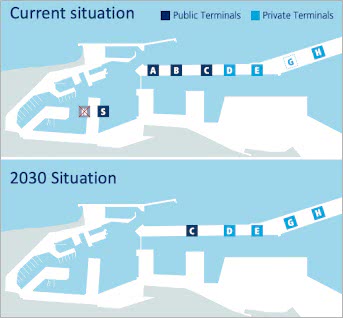
Today, the Barcelona City Council and Port Authority have
signed an agreement to reorganize the activities
cruise lines and make them more sustainable for the city
which provides for the reduction of the number of terminals from seven to five
cruises to the Adossat Pier of the port with the suppression of three of the
four public terminals and the maintenance of the three terminals
private management - Costa Cruises' terminal D, terminal E
of the Carnival group and MSC Cruises' Terminal H - to which
will add a fourth (terminal G) under construction that
will be operated by Catalonia Cruise Terminal, a joint venture
between the American cruise group Royal Caribbean and Cruise
Terminals International (CTI) which is a company
owned by Royal Caribbean itself (10%) and by funds managed by
iCON Infrastructure (90%).
 In particular, the agreement provides that the reduction in the number of
cruise terminal is the result of the demolition of the current
public terminals A, B and C, which are the oldest in the port,
and the construction of a new terminal that will replace the
terminal C and which will be public, open to the public and with a
capacity for 7,000 passengers. The new terminal will give
priority to cruises that have Barcelona as their home port and
to small ships.
In particular, the agreement provides that the reduction in the number of
cruise terminal is the result of the demolition of the current
public terminals A, B and C, which are the oldest in the port,
and the construction of a new terminal that will replace the
terminal C and which will be public, open to the public and with a
capacity for 7,000 passengers. The new terminal will give
priority to cruises that have Barcelona as their home port and
to small ships.
It will also be
A complete renovation of the long stretch of pier has been carried out
610 meters currently occupied by terminals A and B, with a
investment of 50 million euros by the Authority
Port with the aim of making port facilities dedicated to
to the most modern and sustainable cruise ships in
international level, in particular with regard to the
of home port. In addition, the redevelopment of the pier will allow
the installation of systems to connect ships to the electricity grid
to allow the on-board engines to be switched off by eliminating
emissions.
The agreement also includes measures to carry out three
sustainable mobility: the subdivision of the Porta bridge
to improve the mobility of the pier and its
connection in safety, integrating cycle and pedestrian paths
with an expected investment of 90 million euros; Construction
of an urban corridor along the Montjuïc coast for the
public transport, which will connect Plaça de les
Drassanes with Marina del Prat Vermell and the Free Zone, with a
expected investment of about 10 million euros; Preparation
of a study to assess the mobility generated by ships from
as a preliminary phase to the formulation of a
sustainable management of land mobility for
cruise passengers, in line with the policies adopted in the areas with
high traffic.
The plan will be launched in 2026 with the closure of the
terminal at the Barcelona South Pier and the demolition of the current one
terminal C by the end of the year. The following year it will be
construction of the new public terminal on the Adassat Pier has begun,
the study to assess mobility will be carried out
generated by cruise ships docking at Molo Adossat, will be
inaugurated the terminal G currently under construction and will be
started the work of doubling the Porta d'Europa bridge. In the
2028 the new terminal C is scheduled to come into operation,
the demolition of terminals A and B in the second half
of the year and the start of the renovation of the section of the pier
Adossat where terminals A and B are currently located as well as
the installation of the OPS system for the electrification of
Docks. In 2029, the
urban corridor that will connect Plaça de les Drassanes
with the Marina del Prat Vermell and the Free Zone and in 2023 it is
the new terminal C is expected to be fully operational.
In total, an investment will be allocated
of 185 million euros which will be added to the
€265 million already invested on the basis of the previous
agreement between the parties signed in 2018.
On the occasion of today's signing of the agreement, the mayor of
Barcelona, Jaume Collboni, highlighted that, for the first time
in history, there is a limit to the growth of cruises in
city" and expressed gratitude to the port for "the
effort of understanding and empathy", recognizing that the
growth of this business segment cannot be
infinite and must be limited. Recalling that from 2018 to 2024 the
number of cruise passengers has increased by +20% since the last
protocol signed between the port and the Municipality has not set limits of
capacity, the mayor underlined that "the current
Tourism management involves setting boundaries and managing
better".